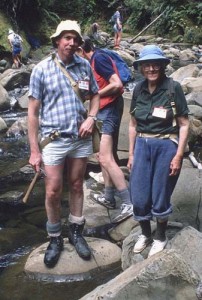 Dr James Crampton, paleontologist and programme leader at GNS Science, comments:
Dr James Crampton, paleontologist and programme leader at GNS Science, comments:
“I guess for me, her story is a wonderful example of the intense interest, drive and energy that motivate many natural historians – amateur and professional scientists alike – the “simple” joy of discovery that has led to all the great scientific discoveries throughout history. Like a prize-winning film, novel or painting, or a stunning sports victory, Joan’s work has enriched our national identity, so that “our” dinosaurs now reside in the psyche of many (most?) New Zealanders. What a great legacy! I suggest that her success as an amateur also appeals to New Zealander’s egalitarian and “number 8 wire” ethos.
Associate Professor Ewan Fordyce, Head of the Department of Geology at Otago University, comments:
Joan Wiffen did what a good vertebrate paleontologist should. She started her work prompted by reports of fossil bones. She organised field groups, recovered new material, prepared it, and saw it written up. She sought and received support from NZ Geological Survey (now GNS Sciences). She developed excellent collaborations especially with other vertebrate paleontologists overseas, notably Dr Ralph Molnar then of Queensland Museum. She produced a series of scientific publications on Late Cretaceous biotas, including bony fish, sea turtles, mosasaurs, plesiosaurs, dinosaurs and pterosaurs. Such articles are the fundamentals of paleontology, and they give a certain immortality to the writer. It is a tribute to Joan and her associates that her work will be referred to a hundred years hence.
Dr Ralph E. Molnar, vertebrate paleontologist and co-author of many of Joan Wiffen’s publications, comments:
“Joan was the primary figure in the discovery of dinosaurs and other Mesozoic terrestrial vertebrates in New Zealand. Thirty some years ago, in the 1970’s she and her husband, known to his friends as Pont, decided to hunt for vertebrate fossils in North Island. They tracked down a map from a petroleum company that noted “reptilian bones” in the Te Hoe Valley. In their 50’s, when most of us would be contemplating retirement, they took up prospecting for reptilian fossils. At this time, Cretaceous marine reptiles were known from New Zealand, but no land-living creatures. By 1980, in addition to fossils of marine reptiles, Joan and Pont had discovered a single bone of a dinosaur, the first from New Zealand. Her later work was to reveal evidence of probably five types of dinosaur, as well as of one flying reptile (pterosaur). This is set out in her 1991 book ‘Valley of the Dragons’.
“Joan’s work is significant in several ways. To me, however, Joan’s chief significance is not in what she found, but what she did with her discoveries. Without formal university training, Joan taught herself not only how to extract the fossils from the recalcitrant rocks in which they were embedded, and which would tax many formally trained technicians, but also to describe these remains scientifically, and publish their descriptions in scientific journals. Regardless of what kinds of expensive education, equipment or expeditions may be necessary in certain circumstances, Joan showed that the interested, logical and critical mind is the single most important factor in success. She showed that a person with these qualities can make important contributions to their chosen field. She had scientific papers published not only in New Zealand, but also Australia, the U.S. and Brazil and was awarded the Morris K. Skinner award by the Society of Vertebrate Paleontology for her contributions to the science. She will be long remembered and much missed.”
Dr Hamish Campbell, geologist and Senior scientist, GNS Science comments:
“I first met Joan in early 1980 at the 5th Gondwana Symposium in Wellington, at which it was announced that NZ has dinosaur fossils. I visited the dinosur fossil locality in Mangahouanga Stream (Te Hoe River, inland Hawkes Bay) with Joan as part of a Geological Society of New Zealand one-day field excursion (on Nov 29) during the 1990 GSNZ conference held in Napier. It was on this occasion that she slipped and broke her arm against a boulder in Manghahouanga Stream itself!
“I last saw Joan about a year ago at a talk that I gave in Napier associated with ‘NZ Fossils: Dead Precious!’, a touring exhibition that was at the National Aquarium. I last heard from her just a few months ago. She had written to say how much she enjoyed reading my book: ‘In search of ancient New Zealand’.
“She was a remarkable ‘kiwi’ woman in many ways and a very fine example to all of us. As New Zealanders, we can all identify with her spirit. In talking with her, I discovered what a tough time she had as a child. She had to overcome considerable adversity.
“Her greatest legacy to my mind is not so much the chance discovery of the first dinosaur fossil from New Zealand in 1975, but the subsequent discovery of at least six different kinds of dinosaur from the one
locality are (Mangahouanga Stream). This is confirmation beyond all doubt that the NZ landmass (Zealandia as it was c.80 million years ago) had dinosaurs.The implications of this are profound. It means that we must
have had representatives of the rest of animal life at that time, including mammals.”